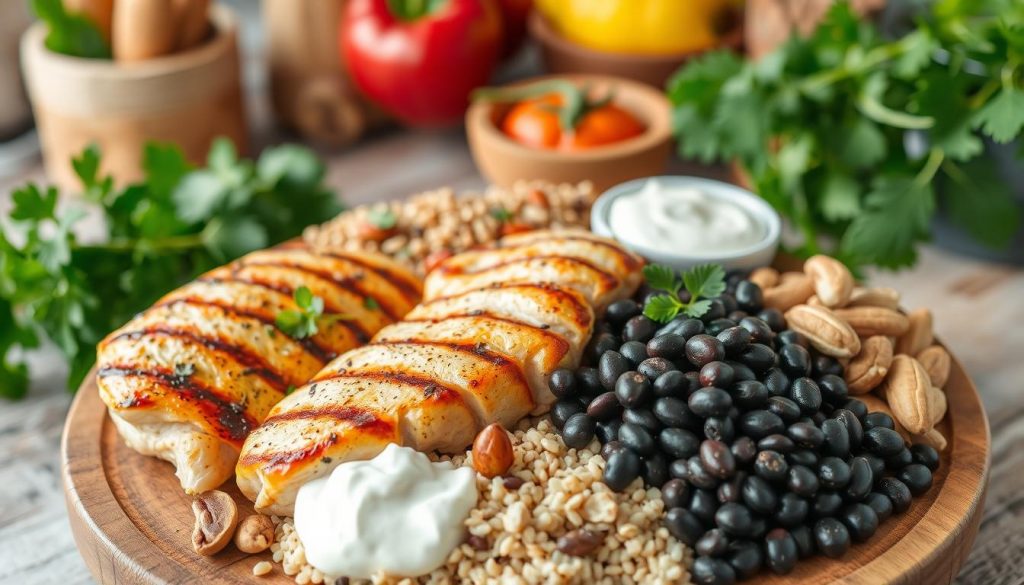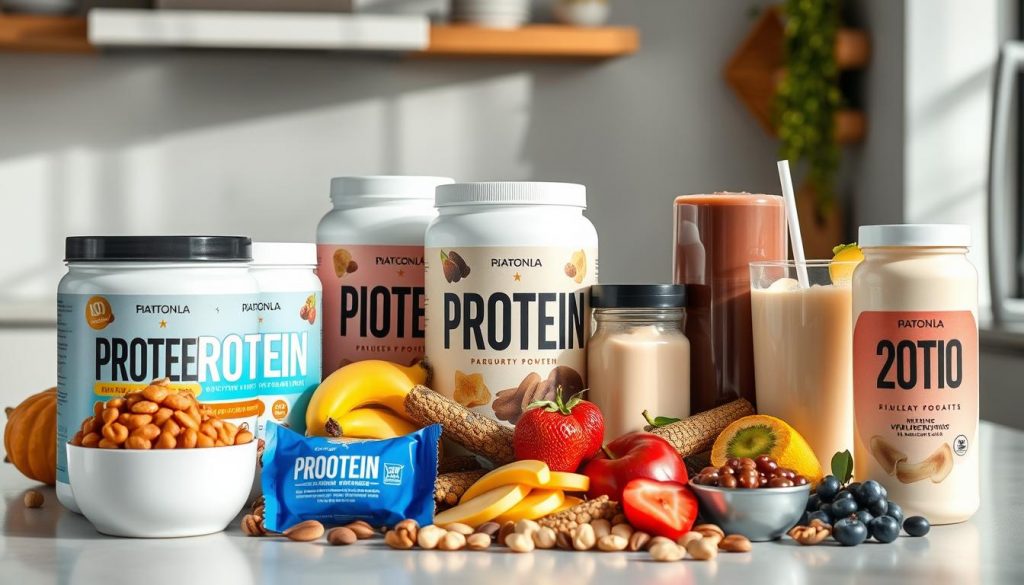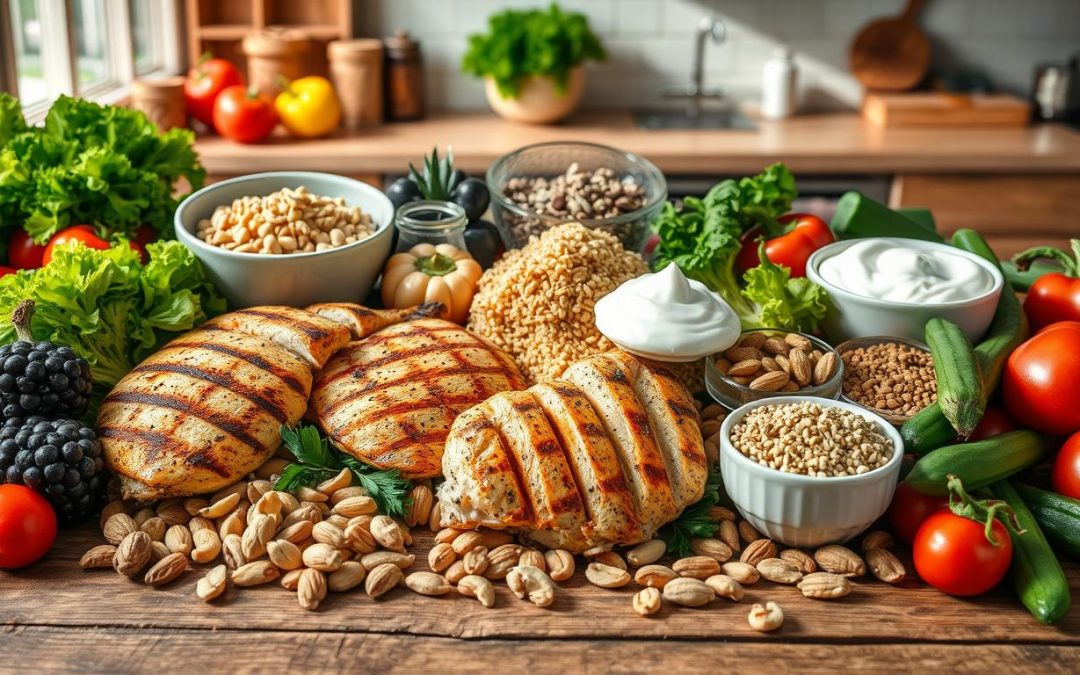Surprisingly, 80% of fitness fans now eat more protein to help their muscles recover and grow1. This shows a big trend in high-protein diets. The global market for high-protein foods is expected to grow fast, reaching $6.2 billion by 20281. This growth shows how much people are interested in these diets and foods.
High-protein diets are known for helping with weight loss, boosting energy, and improving sports performance. They are a favorite among those who want to stay fit and healthy. By following these diets, you can reach your fitness goals and feel better overall.
Table of Contents
Key Takeaways
- High-protein diet trends are gaining popularity, with 35% of US adults planning to increase their protein consumption1.
- High-protein diets can aid in weight loss, improve energy, and enhance athletic performance.
- Protein-rich foods, such as lean meats, fish, and eggs, are essential for a high-protein diet.
- A well-rounded high-protein diet often includes a balance of macronutrients—around 20% protein, 50% carbohydrates, and 30% fat2.
- High-protein diets may boost metabolic rate and increase satiety, which can lead to decreased hunger2.
- Experts recommend consuming between 0.5 grams and 1.0 gram of protein per pound of body weight3.
Understanding High-Protein Diets
High-protein diets mean eating more protein than usual. They focus on lean proteins like chicken, fish, and legumes. These diets help with weight loss, better blood sugar control, and more muscle4. In 2022, there was a big jump in high-protein product sales, showing their growing popularity4.
How much protein you need depends on your age, weight, and how active you are. The general guideline is 0.9 g of protein per kilogram of body weight daily4. But athletes might need 1.2 to 2.0 g per kilogram of body weight daily5. Making a high-protein meal plan can be tough, but it’s worth it for better health.
Some people think high-protein diets are only for athletes or are bad for the kidneys. But studies show they can help anyone’s health. Protein sales saw a 18.1% increase in early 2022 compared to 20214. Always talk to a doctor or dietitian before starting a high-protein diet.
Popular High-Protein Diets Today
Looking into protein diet for weight loss, you have many choices. You can add protein-rich foods like lean meats, fish, and eggs to your meals. Online searches for “high protein” hit a five-year peak in early 20236.
Some diets that are high in protein include:
- The Ketogenic Diet: a diet high in fat and low in carbs, helping with weight loss and health.
- Paleo: focuses on whole, unprocessed foods, avoiding dairy and grains.
- The Dukan Diet: a diet with four phases, high in protein and low in carbs.
Finding a diet that fits your life and taste is key. Talk to a healthcare provider or a dietitian to find the right one for you. Make sure to eat a variety of protein-rich foods like Greek yogurt, milk, eggs, tofu, salmon, lean beef, turkey, skinless chicken breasts, and liver. These are some of the healthiest high-protein foods7.
The Role of Protein in Muscle Building
Protein is key for building muscles. It helps repair muscles after exercise by providing the necessary building blocks. This is important for both athletes and non-athletes8. A diet rich in protein can increase muscle mass and strength. This can be done with a mix of high-protein meals and supplements9.
There are many ways to get protein, like lean meats, fish, eggs, dairy, and plant-based foods. For example, chicken breast, cooked salmon, and ground beef are all high in protein. They have about 24, 21, and 22 grams of protein per 3-ounce serving, respectively10. Greek yogurt, milk, and cheese are also good sources, with 18-22 grams, 8 grams, and 5-7 grams per cup, respectively10.
The amount of protein you need depends on your age, sex, and how active you are. Athletes usually need more protein to grow and recover muscles. They should aim for 1.2 to 2.0 grams of protein per kilogram of body weight per day8. A good high-protein meal plan and supplements can help you reach your fitness goals and improve your health.
Eating a high-protein diet has many benefits. It can increase muscle mass and strength, improve bone density, and help with weight loss. It also makes you feel full, which can help with dieting. Adding high-protein foods and supplements to your diet can greatly benefit your health and help you achieve your fitness goals9.
Plant-Based High-Protein Options
Many think high-protein foods come from animals, but plants offer great options too. Legumes like soybeans, common beans, peas, and chickpeas are packed with nutrients. They have carbs, protein, energy, vitamins, minerals, and fiber11. These foods are not just high in protein but also in fiber, vitamins, and minerals, making them perfect for a high-protein diet.
Quinoa is a complete protein, meaning it has all nine essential amino acids. Nuts and seeds are also rich in protein and healthy fats. They’re great for a high-protein diet. Foods like lentils, chickpeas, and black beans are also high in protein. Plant-based dairy alternatives are becoming more popular, with a +88.3% CAGR globally12.
Here are some examples of high-protein plant-based foods:
- Legumes (soybeans, common beans, peas, chickpeas)
- Quinoa
- Nuts and seeds (almonds, chia seeds, hemp seeds)
- Lentils
- Black beans
High-protein diets offer many benefits. Adding plant-based high-protein options helps you reach fitness goals and promotes a healthy lifestyle13.
| Food | Protein Content |
|---|---|
| Legumes | 15-20 grams per 1 cup cooked |
| Quinoa | 8 grams per 1 cup cooked |
| Nuts and seeds | 5-10 grams per 1 ounce |
Adding these high-protein plant-based foods to your diet can improve muscle mass and overall health11.
High-Protein Diets for Weight Loss
Understanding how protein affects hunger is key when trying to lose weight14. Protein is harder to digest than carbs or fat, which can make you feel fuller longer14. A diet rich in protein can help you lose weight by keeping your muscles strong and reducing fat15.
Eating more protein can also make you less hungry and boost your metabolism14. Experts suggest eating 1.6 grams of protein for every kilogram of your body weight daily15. For instance, a 150-pound person needs about 55 grams of protein each day14. Good sources of protein include lean meats, fish, eggs, and low-fat dairy15.
Studies have found that high-protein diets can lead to notable weight loss and better body shape14. But, eating too much protein can cause stomach problems and harm your kidneys14. So, it’s important to eat a balanced diet and talk to a doctor before starting any new diet15.
The Impact of Protein on Metabolism
High-protein recipes and foods offer many benefits. One key advantage is how protein boosts metabolism. Protein burns more calories than carbs or fat, helping with fat loss16. This is because it takes more energy to digest protein, which can increase your metabolic rate.
Eating more protein can burn about 80-100 extra calories each day16. This is great for those trying to lose weight or get healthier. Also, protein can help reduce fat storage and improve body shape. For instance, a study showed a high-protein diet led to a big drop in fat mass, averaging -3.3 kg17.
| Protein Intake | Recommended Daily Intake |
|---|---|
| Sedentary individuals | 0.8 grams per kilogram of body weight16 |
| Competitive athletes | up to 2 grams per kilogram of body weight16 |
Adding high-protein recipes to your diet can boost metabolism and body shape. Knowing how protein affects metabolism helps you make better diet choices17.

High-Protein Snacks to Try
Snacks are key to boosting your protein intake. They should be tasty and packed with protein. Try making your own protein bars or grab Wilde Protein Chips, with 13 grams of protein in each bag18. Or, go for Quest Nutrition’s Chocolate Chip Protein Cookie, which is high in protein and fiber but low in sugar18.
Beef jerky is a great snack, with 9 grams of protein per ounce19. Greek yogurt has 20 grams of protein in every 200-g serving19. Trail mix and turkey roll-ups are also good, with 8 and 12 grams of protein respectively19.
Don’t forget about canned tuna, with 20 grams of protein in 3 ounces19. Hard-boiled eggs are another good choice, with 6 grams of protein each19. For easy options, look at Whisps Cheese Crisps or The Only Bean Crunchy Roasted Edamame Bean Snacks, both with 13 and 14 grams of protein per serving18.
Adding these snacks to your diet helps with muscle growth and recovery. Make sure they fit your high-protein meal plans. If needed, use protein supplements to meet your protein goals.
Meal Planning with a High-Protein Focus
Following a high-protein diet means planning your meals carefully. This ensures you get enough protein from various sources. A good high-protein meal plan helps you reach your fitness goals, like building muscle or losing weight. It also boosts your health by making you feel full, increasing muscle, and improving overall health20.
Your meal plan should mix protein, healthy fats, and complex carbs. Try meals like cinnamon protein pancakes, breakfast burritos, and peanut butter banana smoothies. These offer about 30 grams of protein per serving20. Make sure to eat a variety of protein-rich foods, like lean meats, fish, eggs, dairy, and plant-based options like tofu and quinoa.
Sample Meal Plans
Here are some meal plans with high-protein foods:
- Breakfast: Greek yogurt with berries and nuts (20 grams of protein)
- Lunch: Grilled chicken breast with brown rice and vegetables (40 grams of protein)
- Dinner: Baked salmon with quinoa and steamed broccoli (50 grams of protein)
These plans help you meet your daily protein needs and offer a balanced mix of nutrients21.
Tips for Balancing Macronutrients
It’s key to balance your macronutrients, including healthy fats and complex carbs. Aim for 0.8 grams of protein per kilogram of body weight daily, adjusting as needed22. A well-planned high-protein meal plan, balanced with macronutrients, helps you reach your fitness goals and stay healthy.
Always talk to a healthcare professional or registered dietitian to find the best meal plan for you.
Supplements to Boost Protein Intake
Boosting protein intake is key for fitness goals. High-protein meal plans are a great way to do this. Protein supplements, like whey protein, are easy to add to your diet, helping with muscle growth and recovery23.
Whey protein is fast-digesting, good for recovery after working out. Plant-based protein is slower-digesting, better for overall health23. Healthy adults need about 0.8 g/kg of protein daily. But, active people might need 1.2 to 2 g/kg23.
Choosing the right protein supplement and timing it right is important. Taking protein before or after a workout helps with muscle growth and recovery23. Plant-based protein supplements are growing fast, with a CAGR of 8.7%23. The US protein supplement market was $2,069.3 million in 2021. It’s expected to hit $10.80 billion by 203023.

A survey showed 41.7% of college athletes use protein products24. Protein deficiency can cause weakness, fatigue, and increase bone fracture risk25. So, it’s vital to focus on protein intake and use supplements if needed. Adding protein supplements to your diet can help you reach your fitness goals.
| Protein Supplement | Benefits |
|---|---|
| Whey Protein | Fast-digesting, beneficial for post-workout recovery |
| Plant-Based Protein | Slower-digesting, beneficial for overall health |
High-Protein Diet and Heart Health
Looking into the benefits of high-protein diets, we must consider their effect on heart health. A diet rich in protein can be good, but we need to know how it affects heart disease. Studies show that eating a lot of protein might raise the risk of atherosclerosis, a condition where arteries get clogged26. The American Heart Association suggests that protein should make up 10% to 35% of our daily calories27.
A well-thought-out high-protein diet can help lower these risks. For instance, a study showed that diets low in carbs but high in protein led to weight loss and lower blood pressure after 6 months27. It’s also key to remember that the general adult protein needs are 0.8 g/kg, with some suggesting more for older adults or those who exercise27.
To keep the heart healthy while enjoying high-protein diets, consider these tips:
- Opt for protein-rich foods that are low in saturated fats and high in fiber
- Go for a balanced high-protein meal plan with a variety of whole, unprocessed foods
- Get advice from a nutritionist or healthcare professional to find what’s best for you
For more details on protein and heart health, check out this study on protein intake and heart disease. By knowing the pros and cons of high-protein diets, you can make smart choices for your diet and keep your heart healthy26.
The Future of High-Protein Diet Trends
As more people want protein in their food, high-protein diet trends will change. They will look for new protein sources and ways to make them sustainably28. Over 80% of people want protein in their food and drinks, leading to more choices that are good for the planet28.
Plant-based proteins like pea and hemp are becoming more popular. Lab-grown meat is also on the rise29. People want to know if their protein is made in a way that’s good for the environment, with 63% looking for this information29.
High-protein diets help build muscle and manage weight. As the world’s population grows, finding ways to make protein that’s good for the planet will be key. It’s predicted that cell-cultured meats won’t be common until at least 202628.
The future of high-protein diets will focus on what people want: sustainable, healthy, and new protein options. It’s about finding a balance between the benefits of protein and making it in a way that’s good for the environment30.
Conclusion: Choosing the Right High-Protein Diet for You
Starting a high-protein diet? First, think about what you need and talk to a nutrition expert3132. They can figure out how much protein you should eat based on your age, sex, weight, and how active you are32. They’ll also show you how to mix different protein sources like lean meats, fish, dairy, and plant-based foods for a healthy diet31.
High-protein diets can help you feel full, boost your metabolism, and manage your weight better33. But, it’s key to not eat too much protein. A nutrition expert can help you find the right balance for your health and fitness goals313233.
FAQ
What is a high-protein diet?
What are the benefits of a high-protein diet?
What are some common myths about high-protein diets?
What are some popular high-protein diets?
How does protein aid in muscle building and repair?
What are some plant-based high-protein options?
How does protein affect weight loss?
How does protein impact metabolism?
What are some high-protein snack options?
How can I plan meals on a high-protein diet?
How can protein supplements be used to boost protein intake?
What is the relationship between high-protein diets and heart health?
What is the future of high-protein diet trends?
How can I choose the right high-protein diet for me?
Source Links
- 10 Awesome Benefits of a High-Protein Diet | Factor – https://www.factor75.com/eat/diet-guide/10-benefits-of-a-high-protein-diet
- Should You Try A High-Protein Diet? – https://www.verywellfit.com/is-a-high-protein-diet-best-for-weight-loss-3495768
- Here’s How Many Grams Of Protein You Should Aim For If You’re Trying To Lose Weight – https://www.womenshealthmag.com/weight-loss/a19907503/protein-weight-loss/
- Changing food choices: the option for high-protein foods and the move away from the Mediterranean diet – https://pmc.ncbi.nlm.nih.gov/articles/PMC11147913/
- The Effects of High-Protein Diets on Kidney Health and Longevity – https://pmc.ncbi.nlm.nih.gov/articles/PMC7460905/
- High-Protein Products as Popular as Ever – The Food Institute – https://foodinstitute.com/focus/high-protein-products-as-popular-as-ever/
- High Protein Foods: 16 Foods for High Protein Meals – https://www.healthline.com/nutrition/high-protein-foods
- Dietary Protein and Muscle Mass: Translating Science to Application and Health Benefit – https://pmc.ncbi.nlm.nih.gov/articles/PMC6566799/
- Higher Protein Intake Is Associated with Higher Lean Mass and Quadriceps Muscle Strength in Adult Men and Women – https://pmc.ncbi.nlm.nih.gov/articles/PMC4478942/
- How Teen Athletes Can Build Muscles with Protein – https://www.eatright.org/health/essential-nutrients/protein/how-teen-athletes-can-build-muscles-with-protein
- Sustaining Protein Nutrition Through Plant-Based Foods – https://pmc.ncbi.nlm.nih.gov/articles/PMC8804093/
- 5 Plant-Based Protein Trends for 2024 – https://www.glanbianutritionals.com/en/nutri-knowledge-center/insights/5-plant-based-protein-trends
- Protein Trends in Plant-Based Meat and Milk. Plant-Protein Market – https://www.innovamarketinsights.com/trends/protein-trends/
- What You Need to Know About High-Protein Diets and Weight Loss – https://seattlesutton.com/blog/highprotein-diets-and-weight-loss/?srsltid=AfmBOoo7uZhTa49jwFIj3i24NQ53R_Z0i3Uiqj_uN8aKYbmlznLqrXtO
- Your Guide to a High-Protein Diet for Weight Loss – https://www.loseit.com/articles/high-protein-diet/
- No title found – https://www.rupahealth.com/post/how-protein-affects-metabolism-impacts-and-insights
- Clinical Evidence and Mechanisms of High-Protein Diet-Induced Weight Loss – https://pmc.ncbi.nlm.nih.gov/articles/PMC7539343/
- The Best High-Protein Snacks, According To Nutritionists – https://www.delish.com/kitchen-tools/cookware-reviews/g62919105/best-high-protein-snacks/
- 30 High Protein Snacks That Are Healthy and Portable – https://www.healthline.com/nutrition/healthy-high-protein-snacks
- Dietitian approved high-protein breakfast ideas to cut cravings | Colorado State University – https://engagement.source.colostate.edu/want-to-stop-craving-snacks-and-sweets-a-high-protein-breakfast-could-help/
- 29 Day High-Protein Dinner Plan for Weight Loss – https://www.eatingwell.com/gallery/8044229/high-protein-dinner-plan-for-weight-loss/
- High-Protein Diet For Weight Loss With a 7-Day Plan – https://sesamecare.com/blog/high-protein-diet-weight-loss-plan?srsltid=AfmBOopS4oKcNftlzmCR_QVRUffD0sk9T03gOG1rWXIK_ERhDVDHTxTe
- Protein supplementation: the double-edged sword – https://pmc.ncbi.nlm.nih.gov/articles/PMC10761008/
- Office of Dietary Supplements – Dietary Supplements for Exercise and Athletic Performance – https://ods.od.nih.gov/factsheets/ExerciseAndAthleticPerformance-HealthProfessional/
- 7 easy ways to up your protein intake – https://www.bswhealth.com/blog/7-easy-ways-to-up-your-protein-intake
- Is a high-protein diet damaging to heart health? – https://www.foodnavigator.com/Article/2024/03/11/is-a-high-protein-diet-damaging-to-heart-health/
- The Impact of High Protein Diets on Cardiovascular Outcomes: A Systematic Review and Meta-Analysis of Prospective Cohort Studies – https://www.mdpi.com/2072-6643/15/6/1372
- The Protein Revolution: Trends Shaping Consumer Choices in 2025 – https://www.preparedfoods.com/articles/129997-the-protein-revolution-trends-shaping-consumer-choices-in-2025
- The Future of Protein – 5 Key Trends for 2023 – https://www.foodnavigator-usa.com/News/Promotional-features/The-Future-of-Protein-5-Key-Trends-for-2023/
- Ten Key Health and Nutrition Trends for 2025 – KHNI – https://khni.kerry.com/trends-and-insights/ten-key-health-and-nutrition-trends-of-this-year/
- Lose weight with a high protein diet | CSIRO Total Wellbeing Diet – https://www.totalwellbeingdiet.com/au/resources/guides/lose-weight-with-a-high-protein-diet/
- Proteins, Diet, and Personal Choices – https://ecampusontario.pressbooks.pub/humannutrition/chapter/proteins-diet-and-personal-choices/
- Low Calorie Diet with High Proteins – https://chefreza.ca/low-calorie-diet-with-high-proteins/

